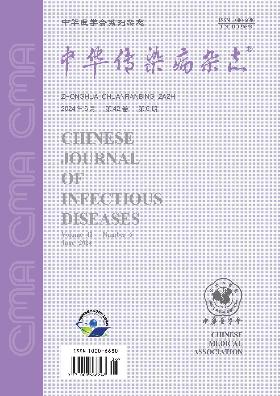Relationship between infection of Toxoplasma gondii and metabolic syndrome
引用次数: 0
Abstract
Objective To investigate the relationship between Toxoplasma gondii (T.gondii) infection and metabolic syndrome (MS). Methods A total of 20 577 patients who received serum test of anti-T.gondii IgG antibody in the National Health and Nutrition Examination Survey (NHANES) of the United States from 2009 to 2014 were collected to analyze the clinical features of anti-T.gondii IgG antibody positive patients, and to compare metabolic related indicators in the antibody IgG positive and negative groups. The independent sample t-test, chi-square test, and logistic regression analysis were used to explore the risk factors of MS. Results A total of 2 746 participants were positive for the T. gondii antibody (13.34%), with a higher prevalence of male (14.44% vs 12.27%, χ2=15.99, P< 0.01). Meanwhile, the prevalence of T. gondii increased with age and body mass index (BMI) (χ2=979.98 and 50.85, respectively, both P<0.01). Among the 2 191 patients with MS, 449 (20.49%) patients were positive for T. gondii. While 2 297(12.49%) patients were anti-T.gondii positive in 18 386 non-MS patients. The difference was statistically significant (χ2=78.504, P<0.01). Age (t=-37.37), BMI (t=-4.28), glycosylated hemoglobin (t=-11.81), fasting blood glucose (t=-9.38), triacylglycerol (t=-6.32), cholesterol (t=-7.16), serum uric acid (t=-5.25) and serum creatinine (t=-7.69) in the seropositive group were all higher than those in the seronegative group (all P<0.01). After adjusting for age and gender, the prevalence of T. gondii was an independent risk factor for MS (odds ratio [OR]=1.147, P=0.023). Conclusions BMI, blood lipids, blood uric acid and blood glucose are significantly increased in patients with T. gondii infection. T. gondii infection is an independent risk factor for MS. Key words: Metabolic syndrome; Risk factors; Toxoplasma gondii刚地弓形虫感染与代谢综合征的关系
目的探讨弓形虫感染与代谢综合征的关系。方法收集2009年至2014年接受美国国家健康与营养调查(NHANES)抗弓形虫IgG抗体血清检测的20577例患者,分析抗弓形虫抗体阳性患者的临床特征,并比较抗体IgG阳性组和阴性组的代谢相关指标。采用独立样本t检验、卡方检验和logistic回归分析探讨MS的危险因素。结果共有2 746名参与者弓形虫抗体阳性(13.34%),其中男性患病率较高(14.44%vs12.27%,χ2=15.99,P<0.01),弓形虫的患病率随年龄和体重指数(BMI)的增加而增加(χ2=979.98和50.85,均P<0.01)。在2191例MS患者中,449例(20.49%)弓形虫阳性。而非MS患者中有18297例(12.49%)抗弓形虫阳性。差异有统计学意义(χ2=78.504,P<0.01)。年龄(t=-37.37)、BMI(t=-4.28)、糖化血红蛋白(t=-11.81)、空腹血糖(t=-9.38)、三酰甘油(t=-6.32)、胆固醇(t=-7.16),血清阳性组的血尿酸(t=-5.25)和血肌酐(t=-7.69)均高于血清阴性组(均P<0.01),弓形虫感染患者的血尿酸和血糖显著升高。弓形虫感染是MS的独立危险因素。关键词:代谢综合征;风险因素;弓形虫
本文章由计算机程序翻译,如有差异,请以英文原文为准。
求助全文
约1分钟内获得全文
求助全文
来源期刊
自引率
0.00%
发文量
5280
期刊介绍:
The Chinese Journal of Infectious Diseases was founded in February 1983. It is an academic journal on infectious diseases supervised by the China Association for Science and Technology, sponsored by the Chinese Medical Association, and hosted by the Shanghai Medical Association. The journal targets infectious disease physicians as its main readers, taking into account physicians of other interdisciplinary disciplines, and timely reports on leading scientific research results and clinical diagnosis and treatment experience in the field of infectious diseases, as well as basic theoretical research that has a guiding role in the clinical practice of infectious diseases and is closely integrated with the actual clinical practice of infectious diseases. Columns include reviews (including editor-in-chief reviews), expert lectures, consensus and guidelines (including interpretations), monographs, short monographs, academic debates, epidemic news, international dynamics, case reports, reviews, lectures, meeting minutes, etc.

 求助内容:
求助内容: 应助结果提醒方式:
应助结果提醒方式:


